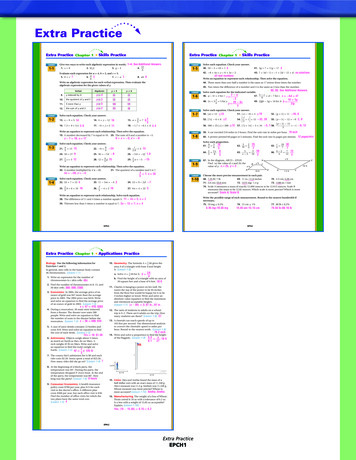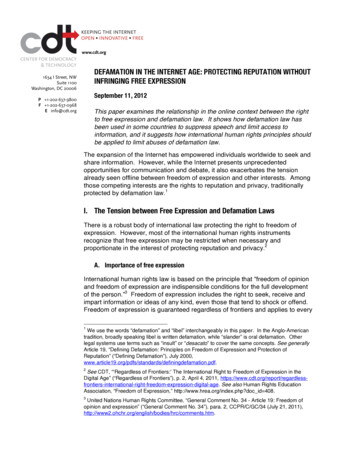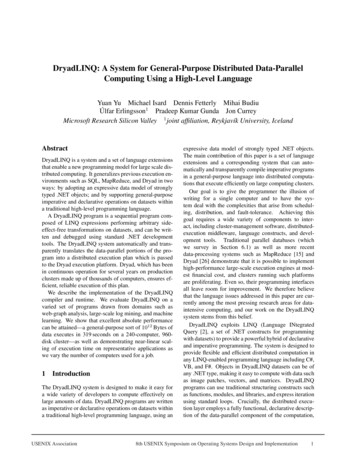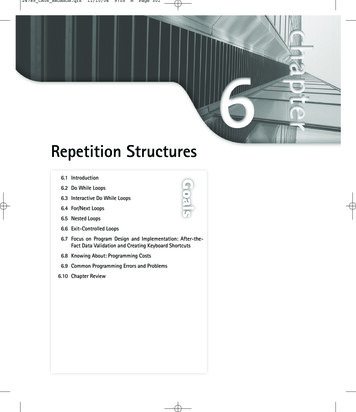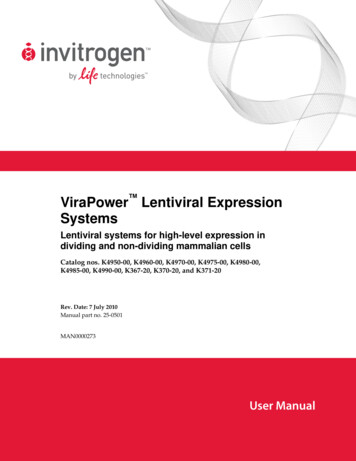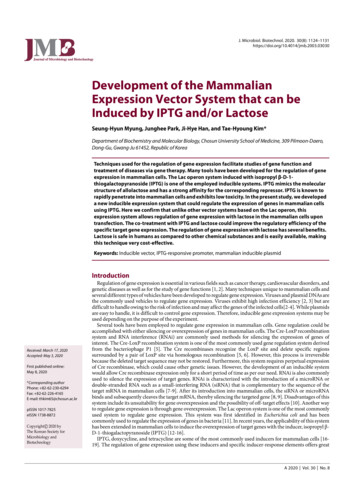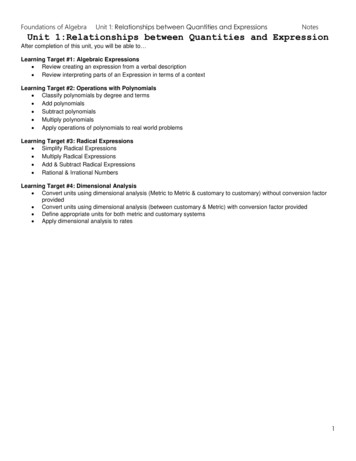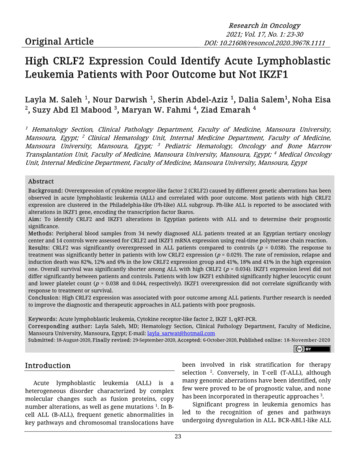
Transcription
Research in Oncology2021; Vol. 17, No. 1: 23-30DOI: 10.21608/resoncol.2020.39678.1111Original ArticleHigh CRLF2 Expression Could Identify Acute LymphoblasticLeukemia Patients with Poor Outcome but Not IKZF1Layla M. Saleh 1 , Nour Darwish 1 , Sherin Abdel-Aziz 1 , Dalia Salem 1 , Noha Eisa2, Suzy Abd El Mabood 3 , Maryan W. Fahmi 4 , Ziad Emarah 4Hematology Section, Clinical Pathology Department, Faculty of Medicine, Mansoura University,Mansoura, Egypt; 2 Clinical Hematology Unit, Internal Medicine Department, Faculty of Medicine,Mansoura University, Mansoura, Egypt; 3 Pediatric Hematology, Oncology and Bone MarrowTransplantation Unit, Faculty of Medicine, Mansoura University, Mansoura, Egypt; 4 Medical OncologyUnit, Internal Medicine Department, Faculty of Medicine, Mansoura University, Mansoura, Egypt1AbstractBackground: Overexpression of cytokine receptor-like factor 2 (CRLF2) caused by different genetic aberrations has beenobserved in acute lymphoblastic leukemia (ALL) and correlated with poor outcome. Most patients with high CRLF2expression are clustered in the Philadelphia-like (Ph-like) ALL subgroup. Ph-like ALL is reported to be associated withalterations in IKZF1 gene, encoding the transcription factor Ikaros.Aim: To identify CRLF2 and IKZF1 alterations in Egyptian patients with ALL and to determine their prognosticsignificance.Methods: Peripheral blood samples from 34 newly diagnosed ALL patients treated at an Egyptian tertiary oncologycenter and 14 controls were assessed for CRLF2 and IKZF1 mRNA expression using real-time polymerase chain reaction.Results: CRLF2 was significantly overexpressed in ALL patients compared to controls (p 0.038). The response totreatment was significantly better in patients with low CRLF2 expression (p 0.029). The rate of remission, relapse andinduction death was 82%, 12% and 6% in the low CRLF2 expression group and 41%, 18% and 41% in the high expressionone. Overall survival was significantly shorter among ALL with high CRLF2 ( p 0.034). IKZF1 expression level did notdiffer significantly between patients and controls. Patients with low IKZF1 exhibited significantly higher leucocytic countand lower platelet count (p 0.038 and 0.044, respectively). IKZF1 overexpression did not correlate significantly withresponse to treatment or survival.Conclusion: High CRLF2 expression was associated with poor outcome among ALL patients. Further research is neededto improve the diagnostic and therapeutic approaches in ALL patients with poor prognosis.Keywords: Acute lymphoblastic leukemia, Cytokine receptor-like factor 2, IKZF 1, qRT-PCR.Corresponding author: Layla Saleh, MD; Hematology Section, Clinical Pathology Department, Faculty of Medicine,Mansoura University, Mansoura, Egypt; E-mail: layla sarwat@hotmail.comSubmitted: 18-August-2020, Finally revised: 29-September-2020, Accepted: 6-October-2020, Published online: 18-November-2020Introductionbeen involved in risk stratification for therapyselection 2. Conversely, in T-cell (T-ALL), althoughmany genomic aberrations have been identified, onlyfew were proved to be of prognostic value, and nonehas been incorporated in therapeutic approaches 3.Significant progress in leukemia genomics hasled to the recognition of genes and pathwaysundergoing dysregulation in ALL. BCR-ABL1-like ALLAcute lymphoblastic leukemia (ALL) is aheterogeneous disorder characterized by complexmolecular changes such as fusion proteins, copynumber alterations, as well as gene mutations 1. In Bcell ALL (B-ALL), frequent genetic abnormalities inkey pathways and chromosomal translocations have23
Layla M. Saleh et alRes Oncol. 2021; 17(1): 23-30.was recognized depending on a gene expressionsignature of leukemic cells that mimics that of BCRABL1–positive ALL, although such leukemic cells donot have a BCR-ABL1 translocation 4. These caseshave a highly diverse range of genetic changes thatactivate tyrosine kinase signaling 5.Philadelphia (Ph)-like ALL was identified as aprovisional entity in the 2016 World HealthOrganization classification of myeloid tumors andacute leukemias 6 and several researches havereported numerous genetic events underlying Ph-likeALL. The frequency of Ph-like ALL in various agesand its related clinical criteria and outcomes haveresulted in the identification of new opportunities forprecision medicine treatments 7. The Ph-like ALLprevalence varies according to age, sex, race andethnicity. Ph-like ALL is more common by three foldsthan Ph-positive ALL among children and peaksamong young adults (up to 30%), with a plateau of 2024% at the age of 40-86 years 8, 9.High cytokine receptor-like factor 2 (CRLF2)expression was reported in about half of Ph-like ALLpatients 10. In one study, high CRLF2 expression levelwas found in 15% of T-ALL patients and wasassociated with worse prognosis, defining a subset ofhigh-risk T-ALL cases who might benefit fromtreatments which hinder JAK/STAT5 signalingpathway activation 11. Several other studiesconfirmed the unfavorable prognosis accompanyingCRLF2 rearrangements including a study on EgyptianALL patients 12, 13. Deletions of the IKZF1 gene weredetected in approximately 28% of BCR-ABL1 negativeALL children and in 80% of adult BCR-ABL1positive patients 14. These deletions correlatedsignificantly with high relapse rate and unfavorableoutcomes in children and adult cases 15. A lack ofcorrelation between IKZF1 deletion and the expectedderegulated IKZF1 gene expression was reported 16,17.These observations prompted us to investigate theexpression of CRLF2 and IKZF1 in a group ofEgyptian ALL patients and their relation to treatmentoutcomes.based on standard cytomorphology in addition toimmunophenotypic criteria.Peripheral bloodsamples were obtained from the 34 ALL cases and 14healthy controls.Mononuclear cells isolation and RNA extractionMononuclear cells underwent isolation via densitygradient centrifugation by lymphocyte separationmedium (Lonza, Walkersville, MD). Isolation of RNAfrom mononuclear cells was performed by miRNeasyMini kits (Qiagen, Germantown, MD). NanoDrop wasutilized to determine the purity and concentration ofRNA.Quantitative real-time polymerase chain reactionHigh capacity reverse transcription kit (AppliedBiosystems) was used to synthesize cDNA from 2 μgRNA. Preparation of 20 μL reaction was performed asfollow: 2 μL 10x RT buffer, 0.8 μL 25x dntps 100 mM,2μl 10x random primers, 1 μL Multiscribe reversetranscriptase enzyme (50U/μl), 1μl RNase inhibitorand 13.2 μL nuclease free water along with theextracted RNA. This was followed by incubation ofsample wells in thermal cycler at 25 C for tenminutes, 37 C for 120 minutes, 85 C for five minutesthen 4 C hold.Real-time quantitative reverse transcriptionpolymerase chain reaction (qRT-PCR) was undergoneon the StepOne utilizing TaqMan gene expressionassays for CRLF2 and IKZF1 (Life Technologies,Grand Island, NY). Real-time PCR was performedusing Applied Biosystems TaqMan Gene ExpressionAssays (CRLF2 assay ID Hs 00845692, IKZF1 assay IDHs 00958474). House-keeping gene GAPDH wasutilized as an internal control. The relative geneexpression concentration was calculated as (2 ΔΔCt).The median value was used to divide patients intolow and high expression groups.Statistical analysisStatistical analyses were done utilizing GraphPadPrism software, La Jolla, CA. Continuous variableswere tested for the normality of distribution usingthe Shapiro-Wilk test. Those with abnormaldistributionwereexpressedasmedian interquartile range (IQR) and analyzed using MannWhitney test. Categorical variables were expressed asnumber percentage and analyzed using chi-squaretest. Overall survival (OS) was considered from theMethodsPatients and controlsThe current work included 34 newly diagnosedchildren and adult ALL cases attending a tertiaryoncology center in Egypt. The diagnosis of ALL was24
Layla M. Saleh et alRes Oncol. 2021; 17(1): 23-30.date of diagnosis to the date of mortality andanalyzed using the Kaplan–Meier method. A p value 0.05 was considered significant.(Figure 1a). The median delta Ct of T-ALL and B-ALLcases was comparable (4.9 [IQR: 1.38-31.75] and 6[IQR: 0.74-30.97], respectively). CRLF2 mRNA levelwas significantly higher in B-ALL and T-ALL casesthan in controls (p 0.042 and 0.016, respectively).On the other hand, there was no significantdifference in the relative expression level of IKZF1mRNA between ALL cases and healthy controls(median [IQR] 30.69 [6.9-94.6] and 17.43 [9.4342.49], respectively; p 0.346) (Figure 1b). Themedian delta Ct of T-ALL and B-ALL cases wascomparable (35.2 [IQR: 7-90.9] and 25.6 [IQR: 6.8-103],respectively; p 0.78). IKZF1 mRNA level was notsignificantly higher in B-ALL and T-ALL cases than incontrols (p 0.47 and 0.34, respectively).Ethical considerationsThe study was approved by the Institution ReviewBoard of the Faculty of Medicine, MansouraUniversity (approval # R/17.9.39). All samples wereobtained in accordance with the Declaration ofHelsinki, with informed consent from the adultpatients or parents/guardians of pediatric patients.ResultsThe characteristics of included patients are shownin Table 1. The median age of the 14 healthy controlswas 17 years (IQR 5-16.25).CorrelationbetweenCRLF2andIKZF1expression levels and patients’ characteristicsThe correlation between CRLF2 and IKZF1expression levels and the clinical characteristics ofpatients is summarized in Table 2. No significantcorrelation was found with age, sex, hemoglobinlevel or the percentage of blasts in bone marrow.Patients with high CRLF2 expression showed a nonsignificant trend toward higher white blood cellscount, lower hemoglobin level, and lower plateletcount when compared to those with low expression.Patients with low IKZF1 expression exhibited asignificantly higher white blood cell count than thosewith high expression, and a significantly lowerplatelets count (Table 2). None of the other variablescorrelated significantly with IKZF1 expression level.Table 1: Characteristics of 34 ALL patientsCharacteristicDescriptionAge (years)Median (IQR)7.5 (5-16.25)Malen (%)21 (62)Femalen (%)13 (38)Adultn (%)7 (21)Childn (%)27 (79)Median (IQR)11.7(5.4-39.3)Haemoglobin (g /dL)Median (IQR)9 (7.5-11)Platelets count (*103 /uL)Median (IQR)53.5 (28-99.5)B-ALLn (%)19 (56)T-ALLn (%)15 (44)Blast % in BMMedian (IQR)90 (72-90)LDH (U/L)Median (IQR)865 (4901678)Aliven (%)23 (68)Deadn (%)11 (32)GenderAdult/ChildWBC count(*103 /uL)ALL immunophenotypeThe relation between CRLF2 and IKZF1expression levels and treatment outcomeThe treatment outcome correlated significantlywith the level of expression of CRLF2 in favour of lowexpression (p 0.029). The response to treatment inpatients with low CRLF2 expression was remission in14 (82%), relapse in 2 (12%) and induction death in 1(6%); while in patients with high expression it wasremission in 7 (41%), relapse in 3 (18%) andinduction death in 7 (41%) (Figure 2a).The treatment outcome did not differ significantlyaccording to the level of IKZF1 expression ( p 0.39).The remission, relapse and induction death rateswere 76%, 6% and 18% in the low IKZF1 expressiongroup and 53%, 18% and 24% in the high expressionone (Figure 2b).Last documented statusALL: Acute lymphoblastic leukemia; BM: Bone marrow, IQR:Interquartile range, LDH: Lactate dehydrogenase, WBC: Whiteblood cellsCRLF2 and IKZF1 gene expression levels amongacute lymphoblastic leukemia patientsCRLF2 mRNA level was significantly higher in ALLpatient than in healthy controls (median [IQR] 4.16[0.7-23.94] and 1.9 [0.21-4.27], respectively; p 0.038)25
Layla M. Saleh et alRes Oncol. 2021; 17(1): 23-30.Table 2: Correlation between patients’ characteristics and the level of expression of CRLF2 and IKZF1 amongacute lymphoblastic leukemia patientsAge (years)GenderMaleFemaleALL typeB-ALLT-ALLWBC count(*103 /μL)Hemoglobin(g/dL)Platelets count(*103 /μL)Blast % in BMLDH (U/L)Median(IQR)Low ( n 17)6(3-14)CRLFHigh ( n 17)11(6-18)n (%)n (%)11 (64.7)6 (35.3)10 (58.8)7 (41.2)n (%)n ian(IQR)11 (64.7)6 0-90)984(508-1899)8 (47.1)9 0(80-90)692(383-1060)Low ( n 17)6(3.5-14)IKZF1High ( n 17)11(5.5-33.5)0.910 (58.8)7 (41.2)11 (64.7)6 (35.3)0.90.4810 (58.8)7 0-90)984(614-1883)9 (52.9)8 2.5-92.5)558(292-1447)0.9p value0.110.430.450.440.890.13p value0.20.0380.770.0440.090.13ALL: Acute lymphoblastic leukemia, BM: Bone marrow, IQR: Interquartile range, LDH: Lactate dehydrogenase, WBC: White blood cellsCRLF2 and IKZF11 expression levels and overallsurvivaland B-ALL subtypes without CRLF2 rearrangementdetected 21. So, it was important to find out a userfriendly and economically diagnostic tool torecognize and identify these cases at presentation.Recently, one group produced an easy, fast andreproducible assay, depending on qRT-PCR analysis,to recognize and predict BCR/ ABL1-like ALL ssion alone was insufficient for inductionof a BCR/ABL1-like profile. But CRLF2 expression wasincluded in common algorithms utilized foridentification of BCR/ABL1-like patients (5, 15, 20).Therefore, we investigated the expression levels ofCRLF2 and IKZF1 in a group of B- and T-ALL patients.The prevalence of Ph-like ALL varies as regardsage, sex, race and ethnicity. Its prevalence isapproximately 21% in adolescents (aged 16-20 years)and 20 - 24% among adults above 40 years, with apeak (27%) among young adults 21 - 39 years of age 9,23.In our study, the prevalence of high CRLF2expression level was more of less similar to thatreported in previous studies. The differences inprevalence may be due to the heterogenicity inpatients' age groups between studies 23, 24. Ethnicitymay be a contributing factor as well, as Hispanicindividuals were found to exhibit a greater Ph-likeIt was found that patients with low CRLF2expression have significantly better OS compared tothose with high expression (HR 0.27 [95%Confidence Interval: 0.092 to 0.897]; p 0.034) (Figure3a). There was no significant difference in OSbetween cases with low and high IKZF1expression(HR 0.56 [95% Confidence Interval: 0.178 to 1.738],p 0.31) (Figure 3b).DiscussionNew molecular markers which could predict pooroutcome, were recently discovered among ALLpatients who do not exhibit known poor-prognosticcriteria and thus they have potential clinical value.Among these is BCR-ABL1-like gene expressionsignature, which has frequent deletions of IKZF1 4, 5,18-20.Identification of BCR/ABL1-like cases is stillchallenging. However, Herold et al 15 reported thatmost (58%) patients with high CRLF2 expressionclustered in this Ph-like ALL subgroup. Those caseswith CRLF2 overexpression were found to correlatewith high-risk ALL markers, and poor OS in both T26
Layla M. Saleh et alRes Oncol. 2021; 17(1): 23-30.ALL prevalence 20, 23. This was explained by thegreater frequency of germline Ph-like ALL riskvariant in GATA3 (rs3824662) 25. Interestingly, thisrisk allele was also observed in a dominantinheritance risk model in an Egyptian study of ALL 26.Our results demonstrated that OS wassignificantly lower in ALL patients with elevatedCRLF2. This is consistent with the results ofpreviously reported studies that showed anassociation between elevated CRLF2 expressionvalues and the relatively unfavorable prognosisamong B-ALL patients 19, 20.Palmi et al 10 demonstrated high CRLF2 expressionlevel in T- ALL and reported to be associated withworse prognosis defining a subset of high risk ALLpatients. In both children and adults, Ph-like ALL wasreported to be associated with high rate of treatmentfailure, and poor survival compared to non-Ph-likeALL patients 10, 19, 20. Similarly, in our study, theoutcome of high CRLF2 patient group is particularlypoor as regard relapse rate, induction deathcompared to low CRLF2 expressing group (p 0.029).The clinical significance of IKZF1 deletions in ALLis still controversial. Mullighan et al 27 describedIKZF1 deletions as a significant predictor ofunfavorable outcome in high-risk B-ALL cases. Onthe other hand, Chen et al 28 failed to confirm thatIKZF1 deletions were independent prognostic markerfor high-risk B-ALL patients.Figure 1: Comparing CRLF2 mRNA (a) and IKZF1mRNA (b) expression in acute lymphoblasticleukemia (ALL) patients to that in healthycontrols (HC) by qRT-PCRFigure 2: Correlation between CRLF2 (a) andIKZF1 (b) expression and treatment outcome inacute lymphoblastic leukemia patients27
Layla M. Saleh et alRes Oncol. 2021; 17(1): 23-30.deletions.Study limitationsThe small number of patients prohibited theassessment of the studied abnormalities as anindependent prognostic indicator in ALL. This wouldnecessitate prospective assessment for CRLF2 andIKZF1 in a larger cohort of both B and T ALL casesand using extensive genetic profile to identify thishigh-risk patient group.ConclusionOur study showed that CRLF2 overexpression waslinked to poor treatment outcome and worse survivalamong ALL patients. These results suggest that it maybe considered in risk stratification-based therapeuticpolicy. More research is required for thedetermination of prognostic significance of IKZF1 inALL patients.AcknowledgmentThe results of the current study were presented as a poster atthe 8th Annual Meeting of the Society of HematologicOncology (SOHO); Houston, Texas, USA; 9-12 September 2020(virtual event).Authors’ contributionConception or design: LMS and ShA; Acquisition, analysis orinterpretation of data: LMS, SuA and MWF; Drafting themanuscript or revising it: All authors; Approval of themanuscript version to be published: All authors; Agreementto be accountable for all aspects of the work: All authors.Figure 3: Correlation between CRLF2 (a) andIKZF1 (b) expression and overall survival inacute lymphoblastic leukemia patientsConflict of interestThe authors declare that they have no conflict of interest todisclose.Data availabilityOur analysis demonstrated no difference in IKZF1expression between T and B-cell ALL and healthycontrols. Palmi et al 16 finding was confirmed by Qaziand Uckun 29 who demonstrated no changes in IKZF1expression from homozygous or heterozygous IKZF1deletions in primary leukemic cells from Ph or Phcases. Also, one study by Palmi et al 16 supported theabsence of association between IKZF1 deletions andderegulated IKZF1 gene expression.Despite these findings, we found a significantlyhigher white blood cells count and lower plateletscount in the low IKZF1 expression patients’ groupwhen compared to those with high IKZF1 expression.This was explained by Palmi et al 16 who advocatedthat the unfavorable outcome of IKZF1 deletionmight related to genetic instability rather thanDeidentified individual participant data used to produce theresults of this study are available from the correspondingauthor (LMS) upon request.FundingThe authors did not receive funding for this study.Study registrationNone.References1.2.28Inaba H, Greaves M, Mullighan CG. Acutelymphoblastic leukaemia. Lancet. 2013; 381(9881):1943-1955.Schultz KR, Bowman WP, Aledo A, et al. Improvedearly event-free survival with imatinib in Philadelphiachromosome-positive acute lymphoblastic leukemia: a
Layla M. Saleh et al3.4.5.6.7.8.9.10.11.12.13.14.Res Oncol. 2021; 17(1): 23-30.children's oncology group study. J Clin Oncol. 2009;27(31): 5175-5181.Fogelstrand L, Staffas A, Wasslavik C, et al. Prognosticimplications of mutations in NOTCH1 and FBXW7 inchildhood T-ALL treated according to the NOPHO ALL1992 and ALL-2000 protocols. Pediatr Blood Cancer.2014; 61(3): 424-430.Den Boer ML, van Slegtenhorst M, De Menezes RX, etal. A subtype of childhood acute lymphoblasticleukaemia with poor treatment outcome: a genomewide classification study. Lancet Oncol. 2009; 10(2):125-134.Roberts KG, Morin RD, Zhang J, et al. Geneticalterations activating kinase and cytokine receptorsignaling in high-risk acute lymphoblastic leukemia.Cancer Cell. 2012; 22(2): 153-166.Arber DA, Orazi A, Hasserjian R, et al. The 2016revision to the World Health Organizationclassification of myeloid neoplasms and acuteleukemia. Blood. 2016; 127(20): 2391-2405.Vesely C, Frech C, Eckert C, et al. Genomic andtranscriptional landscape of P2RY8-CRLF2-positivechildhood acute lymphoblastic leukemia. Leukemia.2017; 31(7): 1491-1501.Roberts KG, Gu Z, Payne-Turner D, et al. Highfrequency and poor outcome of Philadelphiachromosome-like acute lymphoblastic leukemia inadults. J Clin Oncol. 2017; 35(4): 394-401.Tasian SK, Hurtz C, Wertheim GB, et al. High incidenceof Philadelphia chromosome-like acute lymphoblasticleukemia in older adults with B-ALL. Leukemia. 2017;31(4): 981-984.Maude SL, Tasian SK, Vincent T, et al. Targeting JAK1/2and mTOR in murine xenograft models of Ph-likeacute lymphoblastic leukemia. Blood. 2012; 120(17):3510-3518.Palmi C, Savino AM, Silvestri D, et al. CRLF2 overexpression is a poor prognostic marker in childrenwith high risk T-cell acute lymphoblastic leukemia.Oncotarget. 2016; 7(37): 59260-59272.Palmi C, Vendramini E, Silvestri D, et al. Poorprognosis for P2RY8-CRLF2 fusion but not for CRLF2over-expression in children with intermediate risk Bcell precursor acute lymphoblastic leukemia.Leukemia. 2012; 26(10): 2245-2253.Elnahass YH, Fahmy OA, Samra MA, et al. Pooroutcome of CRLF2 rearranged Philadelphia negativeacute lymphoblastic leukemia adults patients. Blood.2018; 132(Supplement 1): 5290.Iacobucci I, Storlazzi CT, Cilloni D, et al. Identificationand molecular characterization of recurrent genomicdeletions on 7p12 in the IKZF1 gene in a large cohortof BCR-ABL1-positive acute lymphoblastic leukemiapatients: on behalf of Gruppo Italiano MalattieEmatologiche dell'Adulto Acute Leukemia Working15.16.17.18.19.20.21.22.23.24.25.29Party (GIMEMA AL WP). Blood. 2009; 114(10): 21592167.Herold T, Schneider S, Metzeler KH, et al. Adults withPhiladelphia chromosome-like acute lymphoblasticleukemia frequently have IGH-CRLF2 and JAK2mutations, persistence of minimal residual diseaseand poor prognosis. Haematologica. 2017; 102(1): 130138.Palmi C, Lana T, Silvestri D, et al. Impact of IKZF1deletions on IKZF1 expression and outcome inPhiladelphia chromosome negative childhood BCPALL. Reply to "incidence and biological significance ofIKZF1/Ikaros gene deletions in pediatric Philadelphiachromosome negative and Philadelphia chromosomepositive B-cell precursor acute lymphoblasticleukemia". Haematologica. 2013; 98(12): e164-165.Qazi S, Ma H, Uckun FM. Absence of genomicIkaros/IKZF1 deletions in pediatric B-precursor acutelymphoblastic leukemia. Int J Mol Med Sci. 2013; 3(9):72-82.Yamashita Y, Shimada A, Yamada T, et al. IKZF1 andCRLF2 gene alterations correlate with poor prognosisin Japanese BCR-ABL1-negative high-risk B-cellprecursor acute lymphoblastic leukemia. PediatrBlood Cancer. 2013; 60(10): 1587-1592.Cario G, Zimmermann M, Romey R, et al. Presence ofthe P2RY8-CRLF2 rearrangement is associated with apoor prognosis in non-high-risk precursor B-cell acutelymphoblastic leukemia in children treated accordingto the ALL-BFM 2000 protocol. Blood. 2010; 115(26):5393-5397.Harvey RC, Mullighan CG, Chen IM, et al.Rearrangement of CRLF2 is associated with mutationof JAK kinases, alteration of IKZF1, Hispanic/Latinoethnicity, and a poor outcome in pediatric Bprogenitor acute lymphoblastic leukemia. Blood. 2010;115(26): 5312-5321.Ge Z, Gu Y, Zhao G, et al. High CRLF2 expressionassociates with IKZF1 dysfunction in adult t. Oncotarget. 2016; 7(31): 49722-49732.Chiaretti S, Messina M, Grammatico S, et al. Rapididentification of BCR/ABL1-like acute lymphoblasticleukaemia patients using a predictive statistical modelbased on quantitative real time-polymerase chainreaction: clinical, prognostic and therapeuticimplications. Br J Haematol. 2018; 181(5): 642-652.Jain N, Roberts KG, Jabbour E, et al. Ph-like acutelymphoblastic leukemia: a high-risk subtype in adults.Blood. 2017; 129(5): 572-581.Tasian SK, Loh ML, Hunger SP. Philadelphiachromosome-like acute lymphoblastic leukemia.Blood. 2017; 130(19): 2064-2072.Perez-Andreu V, Roberts KG, Xu H, et al. A genomewide association study of susceptibility to acute
Layla M. Saleh et al26.27.Res Oncol. 2021; 17(1): 23-30.lymphoblastic leukemia in adolescents and youngadults. Blood. 2015; 125(4): 680-686.Mosaad YM, Elashery R, Darwish A, et al. GATA3rs3824662 gene polymorphism as possible risk factorin a cohort of Egyptian patients with pediatric acutelymphoblastic leukemia and its prognostic impact.Leuk Lymphoma. 2017; 58(3): 689-698.Mullighan CG, Su X, Zhang J, et al. Deletion of IKZF1and prognosis in acute lymphoblastic leukemia. NEngl J Med. 2009; 360(5): 470-480.28.29.30Chen IM, Harvey RC, Mullighan CG, et al. Outcomemodeling with CRLF2, IKZF1, JAK, and minimalresidual disease in pediatric acute lymphoblasticleukemia: a Children's Oncology Group study. Blood.2012; 119(15): 3512-3522.Qazi S, Uckun FM. Incidence and biologicalsignificance of IKZF1/Ikaros gene deletions inpediatric Philadelphia chromosome negative andPhiladelphia chromosome positive B-cell precursoracute lymphoblastic leukemia. Haematologica. 2013;98(12): e151-152.
Unit, Internal Medicine Department, Faculty of Medicine, Mansoura University, Mansoura, Egypt Abstract Background: Overexpression of cytokine receptor-like factor 2 (CRLF2) caused by different genetic aberrations has been observed in acute lymphoblastic leukemia (ALL) and correlated with poor outcome. Most patients with high CRLF2


